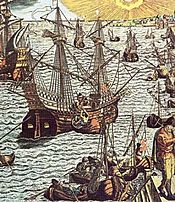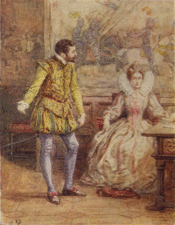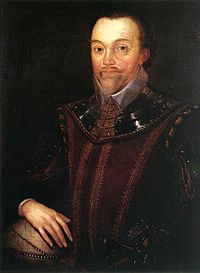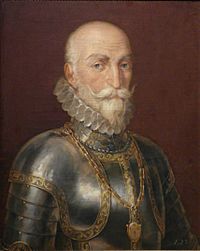Singeing the King of Spain's Beard facts for kids
Quick facts for kids Singeing the King of Spain's Beard |
|||||||
|---|---|---|---|---|---|---|---|
| Part of the Anglo–Spanish War | |||||||
 Drake's map of his attack on Cádiz. |
|||||||
|
|||||||
| Belligerents | |||||||
| Commanders and leaders | |||||||
| Duke of Medina Sidonia (Cádiz) Álvaro de Bazán (Lisbon) |
Francis Drake | ||||||
| Casualties and losses | |||||||
| 1 carrack captured, 4 ships captured, 27 ships destroyed or burnt, ~100 smaller vessels |
Unknown number to disease | ||||||
Singeing the King of Spain's Beard is a funny name for a series of attacks by the English sailor Francis Drake. He led these attacks against Spain in the summer of 1587. The first big attack happened in April on the Spanish city of Cádiz.
Drake's goal was to hit the Spanish navy. Spain was getting ready to send a huge fleet, called the Spanish Armada, to invade England. Drake's raid destroyed many Spanish ships and a lot of their supplies. After Cádiz, Drake attacked several forts along the coast of Portugal. He also captured a Spanish treasure ship coming back from the Americas. All this damage made Spain delay their invasion plans for at least a year.
Contents
Why England and Spain Fought
In the late 1500s, England and Spain had many reasons to be angry with each other.
Religious Differences
England was a Protestant country, led by Elizabeth I of England. Spain was a strong Catholic country, led by Philip II of Spain. The Pope had even kicked Queen Elizabeth out of the Catholic Church. King Philip wanted to get rid of Protestantism.
Money and Power
English sailors, called privateers, often raided Spanish lands and ships in the Americas. These ships carried huge amounts of wealth back to Spain. Spain saw these raids as a big threat to their money. England also supported the Netherlands, who were fighting for their freedom from Spain. This made Spain even angrier.
Spain was also becoming very powerful. In 1580, Spain took control of Portugal and its huge empire. England saw this as a major danger to its own safety.
War Begins
Because of all these problems, England and Spain started a war in 1585. King Philip II of Spain began building a massive fleet, the Spanish Armada. He gathered ships in the Spanish port of Cádiz and the Portuguese port of Lisbon. His plan was to invade England.
Drake's Big Trip
Getting Ready
Queen Elizabeth chose Sir Francis Drake to lead a fleet. Drake was already famous for his naval adventures. His job was to check on Spain's war preparations. He also had to stop their supplies and attack their ships and ports.
The Queen gave Drake four of her own large warships, called galleons. Drake commanded the Elizabeth Bonaventure. Twenty more merchant ships and smaller armed boats joined them. London merchants paid for these extra ships. The Queen would get half of any profits from the trip.
On April 12, 1587, Drake's fleet left Plymouth, England. Seven days later, the Queen sent new orders telling Drake not to attack. But the ship carrying the message couldn't reach him because of strong winds. Some historians think Queen Elizabeth might have secretly wanted Drake to go ahead with the attack anyway. This way, she could deny knowing about it if things went wrong.
Raid on Cádiz
A storm scattered Drake's fleet for several days. After they regrouped, they learned that a large Spanish war fleet was getting ready to sail from Cádiz to Lisbon.
At sunset on April 19, Drake's fleet entered the Bay of Cádiz. There were many Spanish ships there, including sixty large trading ships called carracks. Spanish cannons on shore fired at the English fleet, but they did little damage.
The battle lasted all night and the next day. By dawn on May 1, the English left. They had destroyed between 27 and 37 Spanish ships. They also captured four other ships full of supplies.
Along the Coast of Portugal
After Cádiz, Drake's fleet sailed along the coast of Spain and Portugal. They destroyed any ships they found, even fishing boats. On May 14, about 1,000 English soldiers landed in Lagos. They attacked and captured several forts.
From there, the fleet sailed towards Lisbon. In Lisbon, a Spanish commander named Álvaro de Bazán, 1st Marquis of Santa Cruz was getting more ships ready for the invasion of England. Drake's fleet stopped nearby. There was some cannon fire between the English ships and Spanish forts, but not much damage.
Drake's second-in-command, William Borough, thought attacking the forts was too risky. He disagreed with Drake, so Drake removed him from command and sent him back to England. This left Drake with only nine ships.
Capturing a Treasure Ship

On June 8, Drake's fleet spotted a Portuguese carrack called the São Filipe. It was sailing back from the Americas, loaded with treasure! After a short fight, Drake's men captured it. This was the first time an English ship had captured a treasure ship on its way back from the Indies.
The São Filipe carried an enormous fortune of gold, spices, and silk. It was worth about £108,000, which was a huge amount of money back then. Drake himself got 10% of this treasure. After this big win, the fleet returned to England, arriving on July 6.
What Happened Next
Francis Drake's expedition was a huge success for England. Over one hundred Spanish ships were destroyed or captured. The damage caused by Drake's attack meant that Spain had to delay its invasion plans for over a year. The Spanish Armada was not ready to sail until August 1588.
The English also found important documents on the São Filipe. These papers had details about trade routes and valuable spices from the East Indies. Years later, this information helped create the famous East India Company.
Singeing the King of Spain's Beard
Drake had already caused problems for King Philip with his actions in the West Indies. He had taken towns and ships from Spain, which was the most powerful navy at the time. With this new expedition, Drake brought the fight right to Spain's doorstep. He raided along the Spanish coast and stayed in Spain's main Atlantic port for three days, burning ships and supplies.
These actions made Spain's enemies feel hopeful and worried Spain's friends. Drake even bragged that he had "singed the King of Spain's beard." But secretly, he knew his actions had only delayed the Spanish invasion, not stopped it completely. He wrote to Queen Elizabeth, telling her to "Prepare in England strongly, and mostly by sea. Stop him now and stop him forever."
See also
 In Spanish: Expedición de Drake de 1587 para niños
In Spanish: Expedición de Drake de 1587 para niños




